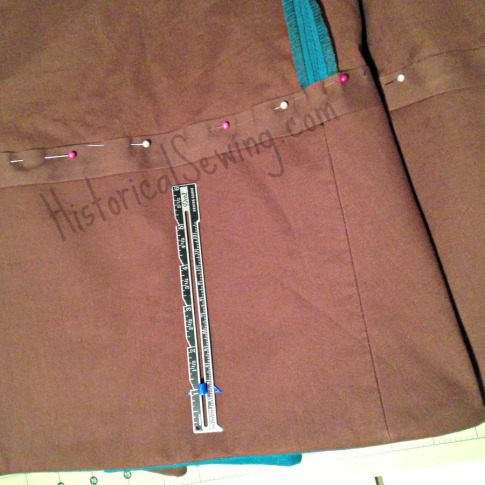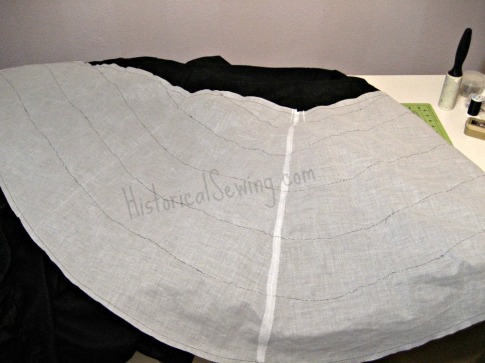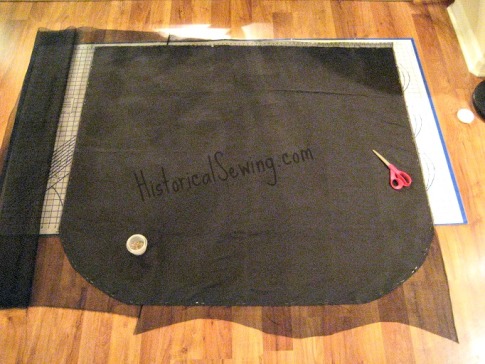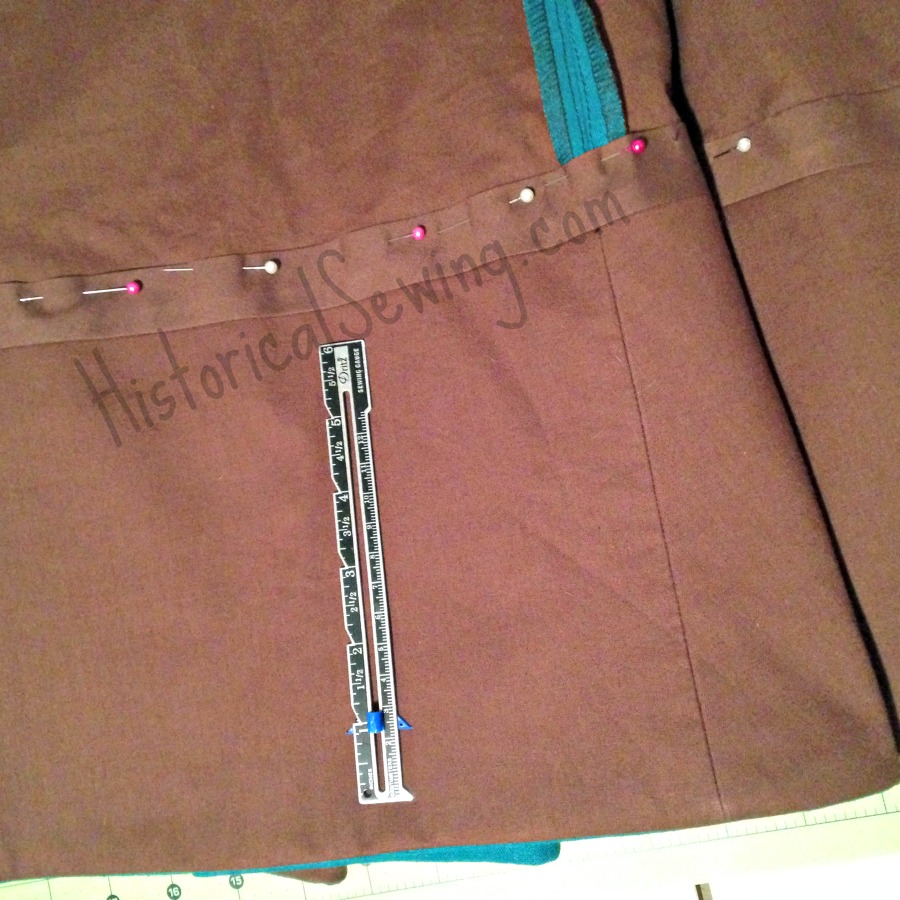
The importance of flatlining skirts cannot be understated. Although, there is a time and place for using underlinings or a lining or both. Or even leaving off linings altogether and simply relying on hem facings and petticoats to keep the silhouette in place.
To follow up my post on how to flatline bodices, let’s go over tips & tricks for flatlining skirts of the 1800s. (Read up on flatlining sleeves as well.)
A lot of the commercial patterns out there for Victorian costumes won’t even discuss the process of using an underlining with a skirt let alone mention it. They rely on using separate linings or just assume the dressmaker knows what they’re doing.
But to make a 19th century skirt consists of a little more than just sew the side seams, turn up the hem and stitch, and slap on a waistband.
The basis of underlining is to support your fashion fabric in the hand of the fabric, layers of trim, and the fashionable silhouette.
Sometimes your fashion fabric is sturdy enough on its own to not need an extra layer of support. But if you intend to make a tailored skirt or one with lots of trims mounted to it, you’ll be happier by backing the fashion fabric with an underlining.

How to Flatline Skirt Panels
The process to add an underlining to your skirt is fairly straightforward. To flatline you cut both the fashion fabric and the underlining fabric from the skirt panel pieces. Then you lay each matching panel together, wrong sides together and baste around the edges.
When flatlining skirt panels I recommend only basting the long, vertical edges and leave the waistband and hem edges open. After seaming, those edges can be basted together if needed.
You’ll want to follow the grain when basting the layers together. For skirt panels this generally means from hem up to waist – from the widest part of the piece to the narrowest.
Keep your basting stitches slightly within the seam line, too, for easy removal or to prevent them from showing on the right side of the garment. At this point it’s super easy to finish the raw edges with either serging or pinking. Or do a hand whipstitch after the seams are sewn.
After flatlining, give the edges a quick press before continuing.
From here on, in the construction you treat each double layer as one piece. Sew up the seams, mount trims and finish with hem and waistband. Yes, the edges will be exposed on the inside. This is period correct to leave as is or add a full lining.
Fabrics for Skirt Underlinings
Good fabric options to mount to the back of your skirt fashion fabric vary (don’t they all!). It really depends on your fashion fabric – how tightly woven it is, the weight, if it’s thin or heavy.
Generally for skirts you can use plain cotton muslin or calico, lightweight twill, poplin, cotton organdy or silk organza. These are my favorites. Linen can be used but make sure to pre-wash once or twice for maximum shrinkage before cutting. You want fabrics that won’t stretch out over time.
I’ve learned over the years that our modern fabrics are simply much heavier than our Victorian ancestors’. So be cautious when selecting an underlining fabric. Play with samples of that silk or wool fashion fabric to see what lays great behind it. That twill may seem like a good choice under a quilting cotton, but it may risk making the skirt awfully heavy and bulky.
Sometimes less is more. You might be surprised at how a thin cotton organdy can give so much body and structure to a skirt. Keep your mind on lighter fabrics rather than heavy materials.

When You Can Skip the Underlining
Yes, there are times you can get away without flatlining your skirt.
Generally, you can leave off the underlining IF you have two or more petticoats that can support your skirt and the silhouette. Petticoats (of which, I widely promote the wearing of) not only help produce the historical silhouette you want but keep the skirts in place. Kind of a backwards idea but it’s true.
Another time to leave off the underlining backing is for sheer dresses. That’s the point of sheers – to keep them light and airy. With these you MUST wear multiple petticoats for support.
If you don’t want to flatline, most often you’ll want to put in a deep hem facing to support the hem and shaping. Keep those petticoats on too!
Specific 19th Century Eras to Flatline Skirts
Regency – no need for flatlining skirts. Although, some bodices will do well with it; the skirts don’t need it. Use petticoats to support the slender silhouette.
1820s & 1830s, Romantic Era – Coming off the slim look of the Regency most skirts, even those cut from light cotton prints, don’t need a full underlining. This is one reason deep hem facings started to be applied. Think of a hem facing as a short underlining fabric mounted just around the hem area.
These Romantic ancestors needed to keep the skirt flare but didn’t want to weigh it down with linings. Petticoats and hem facings… your friends in this fun era. However, if you have heavy rouleux or applied trims so popular in this time, you may want to consider fully flatlining each panel.
1840s to 1860s, Early & Mid-Victorian Era – Skirts of these decades tend to be flatlined with basic polished cotton. Early years were coming off the deep hem facing period and you’ll find originals with both a full underlining and deep facing. Again, it’s all to support the silhouette and fashion fabric. Keep overskirts and wide ruffles light with no underlining but mount on top of a fully flatlined skirt base.
1870s & 1880s, Bustle Era – Yes. Flatline those panels but keep the underlining fabrics lighter than you think. Skirts draped over wire bustle shapes will hang much better when flatlined.
Overskirts are beautiful when backed by organdy or silk organza. It gives them a little bit of body but keeps them light. Not all overskirts need the extra support. Although, some bustle dress designs are rather intricate and will need the structure underlinings give. Play with your fabrics keeping your design in mind.
When making sheer bustle dresses you can get away with the skirts not mounted to anything – keep those petticoats around though! Or merely flatline the foundation skirt, if you need it, keeping the overskirt in just the one fashion fabric layer.
1890s, Late Victorian – These skirts can definitely use the structure underlining provides. Although, some heavy fabrics like wools and twills only require hem facings. Remember that each layer you add to the skirt the heavier it becomes. Did I mention how petticoats are your friend? 🙂

A Tip to Reduce Your Fashion Fabric Yardage Requirement
Now here’s a cheater method that is actually historical correct. In some designs, especially layered looks like in the Bustle Era years, you can cheat on your skirt panels by cutting your expensive fashion fabric short but using a full panel of underlining fabric.
Cut your main skirt panels out of a sturdy twill, poplin or polished cotton. Then, flatline your delicate fashion fabric ON TOP of it at only the sections that will be seen.
You’ll often times see original underskirts with their tan polished cotton underlining visible and the silk mounted to just the hem sections. The overskirt covers the top portion of the cotton so why waste the silk fabric on that area?
The above picture is a skirt side panel with a sheer striped fashion fabric pinned to the top section of the full-cut underlining fabric panel. The white cotton underlining will be covered with ruffles around the hem. – No need to waste fashion fabric when it’ll be covered!
So next time you’re sewing Victorian skirts, consider flatlining each panel to give support to the trims and help produce that wonderful period silhouette you’re shooting for. You’d be surprised at the difference it makes for construction and also the final look of the garment.
Do you flatline your skirts? Have you missed this essential sewing construction step before then realized it later just how valuable it is? Have you made a skirt too heavy by flatlining? (I’m still learning this one…)


For a 1860 ballgown skirt, is it a rectangle that is pleated or is it a bunch of panels
(Sorry for the delay in responding to your comment.)
Both were used. However, until the more elliptical shape came around in the mid-1860s, straight panels were used. After that, shaped gores were cut. Both straight cut and shaped were then pleated to fit the waistband.
Hello! I’m working on an 1890s walking skirt. I have a beautiful poly-wool that I plan to make it out of, however, it’s probably a bit thicker than I should have gone for (similar to jeans in thickness, but not weight).
My only problem is that I would like to be able to wear it with or without petticoats, which means I would like to have a lining, as it does get a bit scratchy. I was thinking about lining it in some cotton organdy or silk organza, as I hope that won’t weigh it down too much. It’s more for the feeling than the shape. I am also putting some 8in horsehair braid in the hem facing to help kick out the bottom.
Should I line it or not? If so, what kind of fabric do you think I should go with?
Absolutely line it! And cotton organdy would be a great choice as it’s lightweight but has the natural stiffness to support the 1890s silhouette. You might consider flatlining in the organdy then covering with a full lining of China silk to make a slick interior that will not stick to cotton petticoats (when you wear them) or other cotton undergarments (modern or historical). If you go with silk organza (again, a great choice) to flatline, then you could leave off a full lining like the China silk as organza would give that “slippery” surface to glide over undergarments. All these options are good and produce a nice historical look and construction layers. Good luck with your project!
I want to use a faux Dupioni silk; would I need to flatline and 1870s skirt and bodice? If so, what you recommend?
Yes, flatline it! Depending on the stiffness of the faux silk I’d recommend a lightweight cotton like batiste. You could also use a silk organza to keep things light.
Hello – I’m getting ready to make a couple of linen walking skirts (late 1800s). I’ve flat lined the wool walking skirts I’ve made. Would you flat line the linen as well, or could I just use petticoats?. One opinion was that lining the linen (unless lining it WITH linen) will change the hand. I just want to be cool. I live in South Carolina and our summers are brutal. Thanks!
I’d go with petticoats as your support and perhaps a decent hem facing on the linen skirt. I flatlined a linen skirt with light cotton and it’s good but heavy. I do like the hang of it, however, and the cotton does keep the shape. You might also consider a light, soft cotton like polished cotton or organdy or even a light sateen simply to help keep the linen in its shape.
Hi Jennifer, I realize Edwardian may not be your speciality, but I’m looking for advice on a 1914 skirt. My fabric is tropical weight wool, it’s lightweight, with good drape. Should I flat line the skirt or not. If a lining is recommended, I was wondering if lawn, muslin or stiff organdy would work…or just add a hem facing. Thank you!
By this time a lot of skirts were made *without* an underlining fabric. They might merely have a hem facing (or deep hem) and may or may not have a lining. For your wool I’d recommend a simple lining (not flatlined) that’s sewn into the waistband but hemmed separately. Put in a hem facing in the wool. For lining fabric, China/habotai silk would be perfect or silk charmeuse. A light polished cotton might work too, but then you’re adding weight to the skirt. But a light silk would be great.
I’m doing a sailor suit in light-meduim linen with the underskirt panel pleated. Would you suggest lining the pleated panel. The pleated area will not go to the waist, but above the knee and mount to a base.
With what you are describing here I’d guess you don’t need to flatline the pleated part, especially if you are mounting to a base. The base, may or may not need an underlining fabric. Remember, the purpose of flatlining is to support and give body to a fashion fabric. Have fun with your suit project!
Hi, Jennifer!
I am in the process of planning a civil war era ball gown skirt that I plan to bead. What advice would you give me for flatlining it? I don’t want my skirt to droop under the weight of the beads but I also don’t want to make the skirt super heavy. What should I do?
Thanks so much!
Quinn
Sounds like a fabulous project, Quinn! I don’t have much beading experience. If you wanted the top as a sheer overlay then you could simply use tear-away or wash-away stabilizer then mount only at the waist to a firm cotton or silk which could be underlined with a basic cotton. If you beading silk taffeta then a basic cotton is fine or silk organza. It depends on what fashion fabric you are beading.
Hi Jennifer, fantastic article! Thank you 🙂
What would you recommend for flatlining an 1860s elliptical skirt of silk duchesse? Since it’s a fairly heavyweight fabric, I wonder if silk organza would make much of a difference – maybe polished cotton would be better?
I’d go for light support – but not the silk organza. A polished cotton is great! Even a plain muslin – that’s what I lined my silk satin 1890s skirt with. Then put in a deep hem facing with organdy underlining the facing.
I’m curious to know why you recommend not tacking the fabrics together at the waistline and hemline when flatlining?
Thank you for a great site – every day is a school day!
Hi Dennis,
Most of the time I leave the waist and hems open when flatlining to both speed up my construction and be only dealing with any “turn of cloth” on the side seams at that point. I generally will baste those edges (fashion fabric and underlining) before enclosing them in a waistband or hem facing. It’s what I’ve found works for me. That said, there are some times I will baste the layers together at top and bottom. This happens most often when dealing with larger skirt panels.
I am making an 1880’s bustle dress from fairly lightweight wool. What kind of material should I use for flatlining the skirt and bodice? Would a cotton weighing 150g per square meter be too heavy, and if so, what weight should I look for?a
Sounds like a great project sanna! I’m not familiar with weights of fabrics but a sturdy cotton like those used for quilting or even a lightweight twill would work well with the wool. You want something with a strong hand and that doesn’t drape too easily (like batiste). Muslin or calico would be ok as well. As you work with the skirt, consider fully flatlining the panels but also adding a hem facing if your wool drapes well. 1880s dresses are well structured and you’ll want that support for the underskirt.
Flatlining an 1860s skirt that will be made from silk taffeta, with an overskirt with swags?
Yea or nay?
I would simply put in a deep hem facing on the skirt and wear over two or three petticoats. Flatlining the entire skirt will make it very heavy and possibly hang heavy with no “life” to it.
Thanks!
Hi Jennifer – I’m planning to make an 1890s evening gown (skirt and top), and am looking at a wonderful silk satin, which has great body. Would you still underline this type of fabric? Thanks – I love your site!
Definitely! For the bodice try silk organza. The skirt could also be flatlined in silk organza or a thin, but stiff, cotton like organdy. If the silk satin is very stiff on it’s own try only a deep hem facing and a full, top-layer petticoat to give it a smooth appearance.
My ears pricked up at this question. I too am making an 1890s evening gown (I asked you a question about it on Facebook the other day!) and mine is now going to be made from powerwoven silk dupion, which is quite stiff. I’ve got soft or stiff cotton organdy for the underlining. Which would you use?
I second Susan’s comment. Your site is unbelievably useful. Thanks!
Anna
Underlining is all about how much stiff or soft support you need for the fashion fabric. For 1890s you can’t go wrong with stiff organdy for the skirt hem. There’s not enough flare in reproduction skirts I see made up. I’m still working on that gorgeous flare myself. Use soft for bodices nearly every time if you use organdy for the underlining.
OK, thanks. So stiff organdy for the skirt hem, but not necessarily for flatlining the whole skirt from waistline to floor? How can I tell how much support my fashion fabric needs without cutting out and assembling the entire skirt? (!)
Good to hear about using soft organdy within the bodice. I’m finding it hard to imagine at the moment how a fabric as translucent as organdy can possibly be tough enough not to get damaged by ruddy great big pieces of boning. Says she who’s never actually used boning before! 😉 I have a cotton poplin that I was considering using for my bodice foundation, as it seems just that bit more robust. What do you reckon?
Thanks very much for your advice! Hope your own projects are going well!
Cotton poplin is a-ok for bodice underlining.
To test, layer the fashion fabric and underlining together (uncut pieces) and hold up to see how they drape together. This is brief way to see how they’ll work together. As you sew more and work with different fabrics your knowledge will get better.
Duh, I’ve just realised I wrote something stupid. You weren’t talking about organdy for the foundation fabric to hold the bones; you were talking about it for the underlining of the fashion fabric. Silly me.
For bone casing, either purchase the ready-made goods or make from sturdy cotton.
The casing for the bones will be made of something a little sturdier than organdy, that is. I think. 😉
Hi, I am about to start an Edwardian outfit for which I have purchased a cotton voile which is embroidered and pintucked already. I was going to flatline this with a pale blue cotton to highlight the patterned voile which is quite light. Would I have to wash the voile first in case it shrinks. This is my first attempt in a long while to do something like this.
I always wash (and recommend washing) cottons and most other fabrics before sewing. Voile too. 🙂
I’m about to cut into my Duchess satin for my 1870s bustle dress and don’t know what flatlining fabric to use… I read somewhere that a tulle would help add some poof to the skirt, but I’m not sure whether it’s a good idea to use it as an underlining fabric. Am I better just going for a cotton organdy? Or perhaps something a little heavier? 🙂
Stiff cotton organdy under the duchess satin would give nice lift to the bustle poufs. Tulle is too soft; although, I do recommend netting sometimes on that back skirt panel.
I’ve made five bustle era skirts for five different people, each done differently. One skirt was stripes of two different fabrics, but I only flatlined one of them because it was a plaid that had to be cut on the bias to maintain the design. Backing each piece with a strip of muslin saved me a world of headaches that would have been caused by sewing a bias to a straight grain. Another skirt was fully underlined because it was a crepe fabric with a heavy ruffled trim, and I didn’t want the trim distorting the beautiful texture of the fabric. Another skirt was almost entirely underlined, minus a contrast section that I wanted to look airy and separate. Two of the skirts were not underlined, one because it was going to be bustled up and I wanted to maintain the poofy-ness of the fabric, and the other because the friend in question tends to overheat easily. I did apply a 9in hem facing as well as horsehair braid to keep the skirt wide and swingy.
I like flatlining, especially if I plan to add any trim to the skirt. It gives structure and stops the skirt from drooping and collapsing under the details. It’s nice to have a guide on when to use it, since I tend to play with different eras.
Jennifer, your timing could not be more perfect! Even though I’m an intermediate seamstress, I just started cutting out my first Victorian (mid-, so hoops) skirt and underlining. As you noted, the pattern doesn’t say anything about the underlining, but I cut one out anyway this morning. And poof!, here’s your article (thankyouthankyouthankyou!!!)! I’m so glad to have your reinforcement!! 😉 The fashion fabric is a mid-weight silk, the underlining muslin. The pattern does include the hem facing, and I’m wondering if I should still use it along with the underlining? I had planned to use polished cotton (let it take the floor abuse!). The outfit is more 1850s, so there’s only going to be one piece of trim on the skirt: 4″-wide ruched silk, 6-8″ up from the hem.
Thank you so much for all you share!
You could do a small hem facing (up to 3″) to keep it basic and give a nice finish and weight to the bottom. Best of luck with it Curious LI!
Thank you, Jennifer. I think 3″ would be easier for me than the 10″ in the pattern.
In addition to structural support, flatlining provides the wonderful bonus of reducing the wrinkle factor, and therefore the necessity of frequent pressing. Who wants to wrestle with iron, ironing board, and all of those fou-fou embellishments on an 1870s gown until you absolutely HAVE to? I’ve found that, even with a 100% cotton or linen dress (which, unlined, means 100% wrinkles the moment you move or sit) and lined with an even lighter cotton or linen, at the end of the day my dress shows nary a wrinkle. Plus you can pack it in a suitcase, padded in the folds with copious amounts of tissue paper, and it still will need little if any pressing when removed. Hurrah for flatlining!